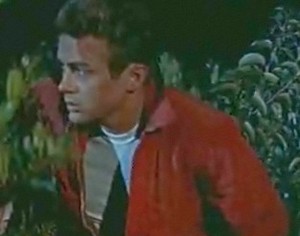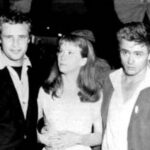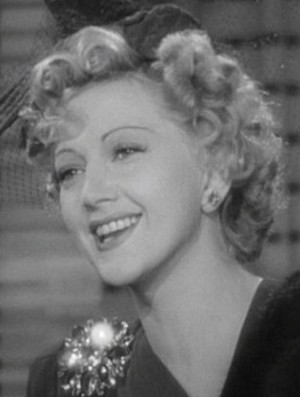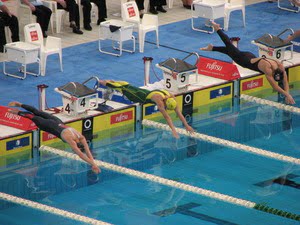James Dean was often criticized in his short acting career (and in his long bout of posthumous fame) of being a clone of Marlon Brando, of too consciously aping Brando’s mannerisms and look. However, while Brando was clearly Dean’s idol, according to director Elia Kazan, he also drew inspiration from Brando’s greatest rival in the first half of the 1950s, Montgomery Clift.
Dean reportedly boated that he was a synthesis of Brando and Clift, that on the one hand, he embodied Marlon’s snarling “F#@% You!” attitude while embodying Monty’s “Help me” vulnerability. James Dean saw himself as a balance of the two, who had established themselves as the lode star (Brando’s hot personality and southern axis (Clift’s cool) of a new, magnetic kind of acting that was evolving after World War II.
Whereas Monty Clift still had the “pretty boy” looks of a classical Hollywood movie star, Marlon Brando was a new kind of star, with looks that were more “Everyman” than your typical Alan Ladd-type poster boy. It was a picture of Ladd that the Plato (Sal Mineo) has taped up in his locker in Rebel Without a Cause, but it was Jimmy Dean’s Jim Star who won Plato’s affection in the classic teenage coming-of-age film that defined the mid-’50s.
A young Gene Hackman, fresh out of the Marine Corps, went to see A Streetcar Named Desire with his father, who thought his son’s desire to study acting on the G.I. bill was far-fetched as Hackman did not look like an actor. After seeing Brando and his anti-movie star look dominate the screen, Gene Hackman knew he would give acting a try as Hollywood was now open to someone with his own, plain looks. Similarly impressed, Hackman’s father gave him his blessing.
With his youthful, handsome face, Dean was neither a Monty Clift pretty boy or bore the idiosyncratic visage of “The Byronic Dead-End Kid” that was Marlon Brando, in critic Pauline Kael’s phrase. In his three major films, he was establishing a niche for himself as an avatar of cool who could also blow very hot when the situation called for it.
Sal Mineo’s Plato in Rebel Without a Cause might have been the first, but definitely was not the last teenager to be blown away by Jimmy Dean. It was James Dean, the immortal and forever young incon — not Brando or Clift — who defined the rebelliousness of an era to the tail-end of the post-war Silent Generation and the new, succeeding Baby Boom generation.
In his three major films, James Dean established a niche for himself as an avatar of cool who could also blow very hot when the situation called for it. It was this duality that made his legend last and grow, into the 1960s, when both Brando and Clift had became passé, one because of his execrable choice of films before his career was redeemed by The Godfather and Last Tango in Paris, the other due to his alcohilism and drug abuse that eroded his talent and led to his utimely death in 1966 at the age of 45.
Yes, it was Marlon Brando as “Johnny” in his biker leathers from The Wild One (a movie that was banned in Britain until the 1970s due to its violence) that graces the cover of Sergeant Pepper’s Lonely Hearts Club Band, but it was James Dean who remained an idol to the youth that now commanded the culture.









